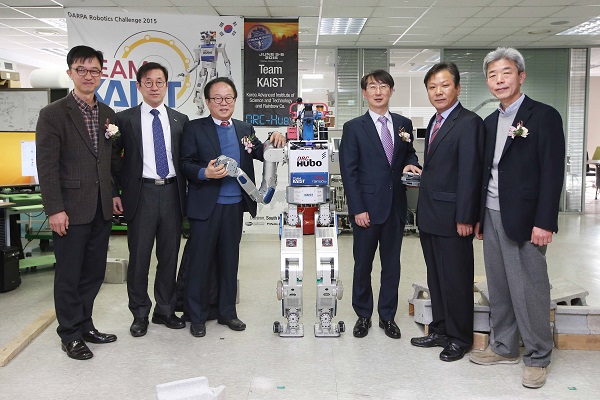policy

(Photo from left: Kyong-Hoon Kim from Korea Evaluation Institute of Industrial Technology, Vice President of Research at KAIST Hee-Yoon Lee, Director Oh, Jong-Hwan Kim at the Ministry of Trade, Industry and Energy, President Ki-Han Park at the Korea Institute for Robot Industry Advancement, and Dean of KAIST Institute Yun Chol Chung.)
KAIST opened its Humanoid Robot Research Center on January 19 at the KAIST Institute. Endorsed by the Ministry of Trade, Industry and Energy with 15 billion KRW funding over five years, the center will conduct research for advancing humanoid robot technology and fostering research fellows in the field.
Professor Jun Ho Oh at the Department of Mechanical Engineering will serve as the director of the center. Team KAIST under Professor Oh won the 2015 DARPA Robotics Challenge (DRC) with its humanoid robot DRC-HUBO, beating 23 teams from six countries.
Professor Oh said, “I believe we have already achieved technological prowess through developing the HUBO robot over the past decade. The center will continue to strive for further development of original technology crucial for humanoid robots’ key components. We want to pave the way for having enough of our own technology and needing to bring in technology from abroad. Professor Oh said he will focus on fields such as high-efficiency, high-powered electric drives and hydraulic system humanoid robot capable of executing solid manipulability with high confidence and object recognition intelligence technology. In addition, he said the center will develop module type and extended open software in an effort to disseminate robot technology.
-
event Professor Mikyoung Lim from Mathematical Sciences to Deliver Keynote at International Conference on Applied Inverse Problems
<Professor Mikyoung Lim from KAIST Department of Mathematical Sciences> Professor Mikyoung Lim from KAIST Department of Mathematical Sciences gave a plenary talk on "Research on Inverse Problems based on Geometric Function Theory" at AIP 2025 (12th Applied Inverse Problems Conference). AIP is one of the leading international conferences in applied mathematics, organized biennially by the Inverse Problems International Association (IPIA). This year's conference was held from July 2
2025-08-14 -
event KAIST Takes the Lead in Developing Core Technologies for Generative AI National R&D Project
KAIST (President Kwang Hyung Lee) is leading the transition to AI Transformation (AX) by advancing research topics based on the practical technological demands of industries, fostering AI talent, and demonstrating research outcomes in industrial settings. In this context, KAIST announced on the 13th of August that it is at the forefront of strengthening the nation's AI technology competitiveness by developing core AI technologies via national R&D projects for generative AI led by the Minis
2025-08-13 -
research KAIST develops “FlexGNN,” a graph analysis AI 95 times faster with a single GPU
<(From Left) Donghyoung Han, CTO of GraphAI Co, Ph.D candidate Jeongmin Bae from KAIST, Professor Min-soo Kim from KAIST> Alongside text-based large language models (LLMs) including ChatGPT, in industrial fields, GNN (Graph Neural Network)-based graph AI models that analyze unstructured data such as financial transactions, stocks, social media, and patient records in graph form are being actively used. However, there is a limitation in that full graph learning—training the entire
2025-08-13 -
research KAIST Develops World’s First Wireless OLED Contact Lens for Retinal Diagnostics
<ID-style photograph against a laboratory background featuring an OLED contact lens sample (center), flanked by the principal authors (left: Professor Seunghyup Yoo ; right: Dr. Jee Hoon Sim). Above them (from top to bottom) are: Professor Se Joon Woo, Professor Sei Kwang Hahn, Dr. Su-Bon Kim, and Dr. Hyeonwook Chae> Electroretinography (ERG) is an ophthalmic diagnostic method used to determine whether the retina is functioning normally. It is widely employed for diagnosing hereditary
2025-08-12 -
research KAIST Develops AI That Automatically Designs Optimal Drug Candidates for Cancer-Targeting Mutations
< (From left) Ph.D candidate Wonho Zhung, Ph.D cadidate Joongwon Lee , Prof. Woo Young Kim , Ph.D candidate Jisu Seo > Traditional drug development methods involve identifying a target protin (e.g., a cancer cell receptor) that causes disease, and then searching through countless molecular candidates (potential drugs) that could bind to that protein and block its function. This process is costly, time-consuming, and has a low success rate. KAIST researchers have developed an AI model th
2025-08-12